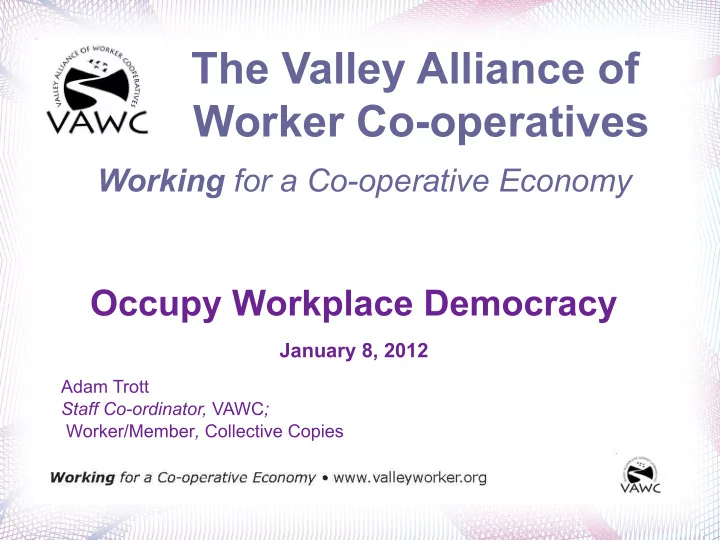

The Valley Alliance of Worker Co-operatives Working for a Co-operative Economy Occupy Workplace Democracy January 8, 2012 Adam Trott Staff Co-ordinator, VAWC ; Worker/Member , Collective Copies
Outline Brief Context of Co-op Movement Questions facing us The Valley Alliance of Worker Co-operatives Resources
The Co-operative Identity Shared among all co-operatives A co-operative is an autonomous association of persons united voluntarily to meet their common economic, social, and cultural needs and aspirations through a jointly- owned and democratically-controlled enterprise. International Co-operative Alliance, 1995 • www.ica.coop
Co-operative Principles Shared among all co-operatives Voluntary & Open Membership Democratic Member Control Member Economic Participation Autonomy & Independence Education, Training & Information Co-operation Among Co-operatives Concern for Community
Co-operative Values Shared among all co-operatives Solidarity Self-Help Honesty Self-Responsibility Openness Democracy Social Responsibility Equality Caring for Others Equity
Questions Facing Us ? ? Why are co-ops useful models for OWS moving forward? ? ? Why organize co-operatives into larger, meso-level, co-operative support organizations?
Questions Facing Us Why are co-ops useful models for OWS moving forward? }
Why are co-ops useful models for OWS moving forward? Co-ops root capital and employment in their communities Worker Co-ops emancipate labor Co-ops as multigenerational asset Co-ops apply a sustainable, democratically/consensus driven economic model for sustainable movements A different economic model: serving members not profit, based on one member, one vote decision making
Questions Facing Our Movement Why organize co-operatives into larger, meso- level, co-operative support organizations?
What is a 'meso-level' organization? ... institutions that are at an intermediate level between micro-level Roles including: units (co-ops) and macro-level institutions (government, parliament, Development central bank, international Public policy organizations, etc.), providing Promotion intermediation of interests and fulfilling Mutual trust a series of functional roles toward Democratic specific micro-level units...* conrol* * From Bruno Roelants, Worker Co-operatives and Socio-Economic Development: The Role of Meso-Level Institutions
Model a) Mondragón Co-operative Corporation Located in Basque region, Spain Started in 1950s First co-op in 1956 (Started with 5 employees, now has 8,000) Premised on Import substitution and social entrepreneurship Started co-op bank with entrepreneurial division (1959) Utilized internal capital accounts for development and retirement $22 Billion in sales, 103,700 workers, 264 co-ops in 2009
Model b) The Region of Emilia Romagna 4 million people 7,500+ co-ops (2/3 are worker co-ops) 30-40% of GDP 2 out 3 are members of co-ops Most co-ops per capita 10% employed by co-ops Cross-sector collaboration Co-op written law – 3% of surplus of all co-ops paid to co-op development High standard of living
What can we learn from successful Co-op Complexes? Shared Characteristics of International Co-operatives Clear co-op identity Co-op led movement Integrated investment in co-op development Focus on innovation, education & co-opreneurship Vision of a co-operative economy Co-op enterprise seen as a multigenerational asset
Valley Alliance of Worker Co-ops Beginnings and Background Started in 2005 to continue energy and development of Eastern Conference for Workplace Democracy Part of a new generation of interco- operative leaders Poses interco-operation as necessary to answer these larger questions Vision and focus on cross sector co-op collaboration
VAWC Region Characteristics Worker Co-operation in western Massachusetts and southern Vermont VAWC: 8 member worker co-operatives Tradition of collective management 65+ worker members, 10+ apprentices $7.1 million revenue (2010) VAWC system has increased in revenue and membership annually for the last three years Linked to/founded from social justice and/or environmental movements
VAWC Co-operative Development A Co-op driven Model Member Co-ops direct, fund and hold staff accountable Co-ops are founded with support from a system – not expected to perform/grow while isolated 5% of Member Co-op's surplus paid to a development fund directed by VAWC members for co-op expansion or new co-ops Shared knowledge and resources save time, energy and funds: Model bylaws and articles of incorporation; legal, lending, accounting, training and process support, etc. Development, support and funding is based on long term goals
VAWC Co-operative Development Recent outcomes Completed two successful conversions, working on third Co-createdCertificate in Co- operative Enterprise, at UMASS, Amherst (www.umasscec.org) Developed and initiated VAWC Co-operative Development Fund On-going ad and PR campaign: Working for a Co-op Economy Co-founded Valley Co-operative Business Association , a cross sector organization in our region
Why organize worker co-operatives into larger, meso-level, co-operative support organizations? Gather resources – oftentimes scarce – to achieve vision Develop particular voice of worker co-operative sector Effectively communicate and partner with other sectors and like- minded organizations Promote, educate and develop as a model Remove strain from individual co-ops, calling all interested co- ops to the table, and managing demand of support and outreach as a system
Organizational Partners Neighboring Food Co-op Association Green Field's Market (a co-managed 2 store food co-op) Valley Co-operative Business Association United States Federation of Worker Co- operatives Co-operative Fund of New England UMASS, Amherst Economics Department
Summary Co-ops provide a useful model for firms as multigenerational economic entities rooting capital and employment, returning investment on behalf of community members Meso-level organizations, co-operatively structured, allow for effective organization and communication of needs creating a 'virtuous cycle' between co-ops and their support systems. Continuing dialog among co-ops and OWS provides resources, tools, and mission driven operations
Resources Valley Alliance of Worker Co-operatives www.valleyworker.org US Federation of Worker Co-operatives www.usworker.coop International Co-operative Alliance www.ica.coop Adam Trott • adam@valleyworker.org Special Thanks to Erbin Crowell • erbin@nfca.coop
Recommend
More recommend